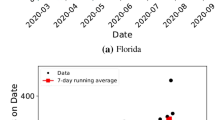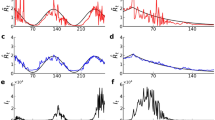Abstract
Infectious disease spread is difficult to accurately measure and model. Even for well-studied pathogens, uncertainties remain regarding dynamics of mixing behavior and how to balance simulation-generated estimates with empirical data. While Markov Chain Monte Carlo approaches sample posteriors given empirical data, health applications of such methods have not considered dynamics associated with model error. We present here an Extended Kalman Filter (EKF) approach for recurrent simulation regrounding as empirical data arrives throughout outbreaks. The approach simultaneously considers empirical data accuracy, growing simulation error between measurements, and supports estimation of changing model parameters. We evaluate our approach using a two-level system, with “ground truth” generated by an agent-based model simulating epidemics over empirical microcontact networks, and noisy measurements fed into an EKF corrected aggregate model. We find that the EKF solution improves outbreak peak estimation and can compensate for inaccuracies in model structure and parameter estimates.
Access this chapter
Tax calculation will be finalised at checkout
Purchases are for personal use only
Preview
Unable to display preview. Download preview PDF.
Similar content being viewed by others
References
Tuite, A., Greer, A., Whelan, M., Winter, A., Lee, B., Yan, P., Wu, J., Moghadas, S., Buckeridge, D., Pourbohloul, B., et al.: Estimated epidemiologic parameters and morbidity associated with pandemic H1N1 influenza. Canadian Medical Association Journal 182(2), 131–136 (2010)
Keeling, M.: The implications of network structure for epidemic dynamics. Theoretical Population Biology 67(1), 1–8 (2005)
Hashemian, M., Qian, W., Stanley, K.G., Osgood, N.D.: Temporal aggregation impacts on epidemio- logical simulations employing microcontact data. BMC Medical Informatics and Decision Making 12(1), 132 (2012)
Machens, A., Gesualdo, F., Rizzo, C., Tozzi, A.E., Barrat, A., Cattuto, C.: An infectious disease model on empirical networks of human contact: bridging the gap between dynamic network data and contact matrices. BMC Infectious Diseases 13(1), 185 (2013)
Mbalawata, I.S., Särkkä, S., Haario, H.: Parameter estimation in stochastic differential equations with markov chain monte carlo and non-linear kalman filtering. Computational Statistics, 1–29 (2012)
Dorigatti, I., Cauchemez, S., Pugliese, A., Ferguson, N.M.: A new approach to characterising infectious disease transmission dynamics from sentinel surveillance: Application to the italian 2009–2010 a H1N1 influenza pandemic. Epidemics 4(1), 9–21 (2012)
Coelho, F.C., Codeço, C.T., Gomes, M.G.M.: A bayesian framework for parameter estimation in dynam- ical models. PloS One 6(5), e19616 (2011)
Osgood, N., Liu, J.: Bayesian parameter estimation of system dynamics models using markov chain monte carlo methods: An informal introduction. In: The 30th International Conference of the System Dynamics Society, p. 19. Curran Associates, Inc, New York (2013)
Tian, Y., Osgood, N.: Comparison between individual-based and aggregate models in the context of tuberculosis transmission. In: The 29th International Conference of the System Dynamics Society, Washington, D.C, p. 29 (2011)
Wang, F.Y.: Toward a revolution in transportation operations: Ai for complex systems. IEEE Intelligent Systems 23(6), 8–13 (2008)
Rahmandad, H., Sterman, J.: Heterogeneity and network structure in the dynamics of diffusion: Comparing agent-based and differential equation models. Management Science 54(5), 998–1014 (2008)
Obeidat, M.: Bayesian estimation of time series of counts. Presentation at the 41st Annual Meeting of the Statistical Society of Canada, Edmonton, May 26-29 (2013)
Chiogna, M., Gaetan, C.: Hierarchical space-time modelling of epidemic dynamics: an application to measles outbreaks. Statistical Methods and Applications 13(1), 55–71 (2004)
Cazelles, B., Chau, N.: Using the kalman filter and dynamic models to assess the changing hiv/aids epidemic. Mathematical Biosciences 140(2), 131–154 (1997)
Chiogna, M., Gaetan, C.: Dynamic generalized linear models with application to environmental epidemiology. Journal of the Royal Statistical Society: Series C (Applied Statistics) 51(4), 453–468 (2002)
Eagle, N., Pentland, A.S., Lazer, D.: Inferring friendship network structure by using mobile phone data. Proceedings of the National Academy of Sciences 106(36), 15274–15278 (2009)
Salathé, M., Kazandjieva, M., Lee, J.W., Levis, P., Feldman, M.W., Jones, J.H.: A high-resolution human contact network for infectious disease transmission. Proceedings of the National Academy of Sciences 107(51), 22020–22025 (2010)
Hashemian, M., Stanley, K., Osgood, N.: Leveraging H1N1 infection transmission modeling with proximity sensor microdata. BMC Medical Informatics and Decision Making 12(1), 35 (2012)
Funk, S., Salathé, M., Jansen, V.A.: Modelling the influence of human behaviour on the spread of infectious diseases: a review. Journal of The Royal Society Interface 7(50), 1247–1256 (2010)
Gelb, A.: Applied optimal estimation. MIT Press (1974)
Osgood, N.: Using traditional and agent based toolset for system dynamics: Present tradeoffs and future evolution. System Dynamics (2007)
Author information
Authors and Affiliations
Editor information
Editors and Affiliations
Rights and permissions
Copyright information
© 2014 Springer International Publishing Switzerland
About this paper
Cite this paper
Qian, W., Osgood, N.D., Stanley, K.G. (2014). Integrating Epidemiological Modeling and Surveillance Data Feeds: A Kalman Filter Based Approach. In: Kennedy, W.G., Agarwal, N., Yang, S.J. (eds) Social Computing, Behavioral-Cultural Modeling and Prediction. SBP 2014. Lecture Notes in Computer Science, vol 8393. Springer, Cham. https://doi.org/10.1007/978-3-319-05579-4_18
Download citation
DOI: https://doi.org/10.1007/978-3-319-05579-4_18
Publisher Name: Springer, Cham
Print ISBN: 978-3-319-05578-7
Online ISBN: 978-3-319-05579-4
eBook Packages: Computer ScienceComputer Science (R0)




